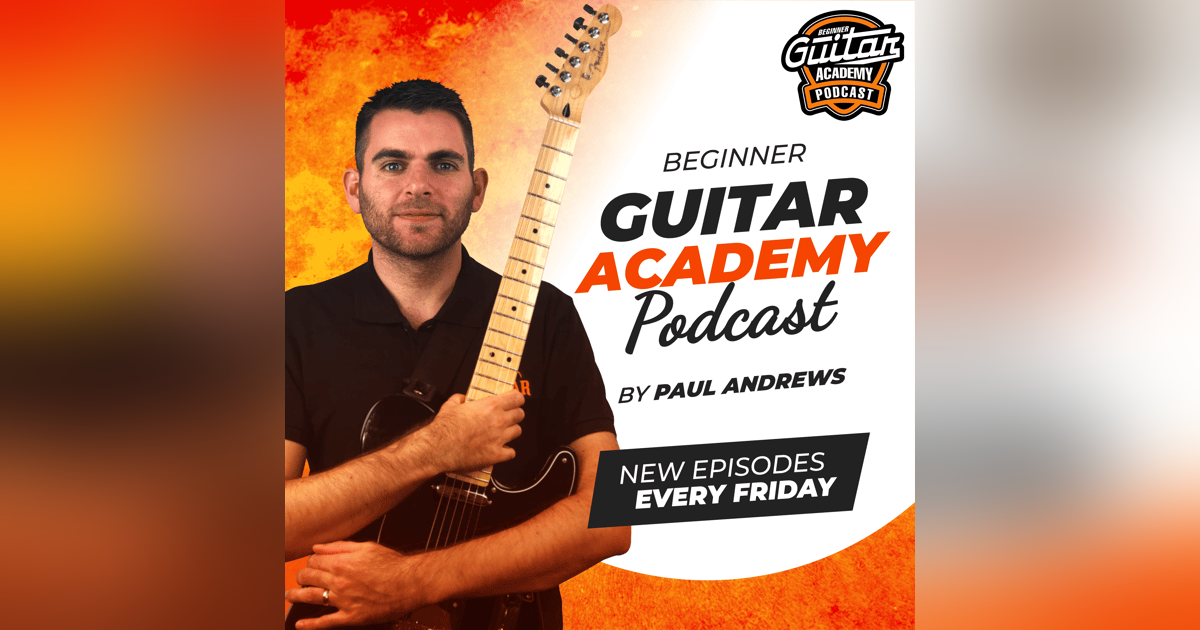253-Demystifying Musical Intervals: Essential Ear Training for Beginner Guitar Players
In episode 253 of the Beginner Guitar Academy Podcast, Paul Andrews explores the powerful—yet often overlooked—concept of musical intervals.
Whether you’re new to the guitar or looking to improve your musicianship, understanding intervals can unlock a deeper grasp of the fretboard, sharpen your ear, accelerate your learning, and even provide inspiration for songwriting.
Paul breaks down what intervals are, explains why they matter, shares practical tips for practicing them, and wraps up with a mini ear-training test.
What’s Covered in This Episode
Announcements for BGA Members
- Upcoming live Q&A on Monday, September 29th (details on times and how to join or submit questions in advance).
- Introduction of 30-minute private guitar lessons exclusively for members ($40 per lesson). Booking details in the community/news section.
- Reminder: Unlimited access to Paul via private video exchange, audio, or text—the new lessons are just an extra option in response to member requests.
Musical Intervals Demystified
What is an interval?
- Simply put, it’s the distance between two notes. Paul demonstrates intervals using open strings and fretted notes, explaining the basic concepts of half steps and whole steps on guitar.
Intervals in the Major Scale:
- Using the C major scale, Paul explains “major second,” “major third,” “perfect fourth,” “perfect fifth,” “major sixth,” “major seventh,” and the “octave.”
- Fun trivia: The term “perfect” dates back to medieval times, referring to intervals considered stable and sacred.
Why are intervals important?
- Ear Training: Recognize famous riffs and melodies (e.g., “Smoke on the Water” – minor third, “Twinkle Twinkle Little Star” – perfect fifth).
- Building Blocks: Chords and scales are literally made by stacking intervals.
- Improvisation & Songwriting: Intervals guide you on which notes work well together.
Practical Ways to Practice Intervals
Play and Sing
- Play intervals on your guitar and try singing them—don’t worry about vocal ability; the goal is to internalise the sounds.
Use Songs as Reference
- Major Second – “Happy Birthday”
- Major Third – “When the Saints Go Marching In”
- Perfect Fourth – “Here Comes the Bride”
- Perfect Fifth – “Twinkle Twinkle Little Star” or the “Star Wars” theme
- Major Sixth – “My Way” (Frank Sinatra)
- Major Seventh – “Take On Me” (a-ha)
- Octave – “Somewhere Over the Rainbow”
Ear Training Apps and Resources
- Apps: MusicTheory.net (free web exercises and the Tenuto app), Earmaster (BGA discount available in the resource section).
- BGA Members: Leverage the ‘Improve Your Ear’ course with tailored exercises.
Start Small
- Begin with just a couple of intervals—like the major second and octave, which have a clear contrast—and add more as you progress.
Ear Training Test
Paul conducts a quick ear training test focusing on major seconds, perfect fifths, and octaves to help listeners start recognising these intervals.
Key Takeaways
- Learning intervals isn’t just “theory”—it’s a real-world tool for mastering the guitar.
- Consistent practice is key: make interval ear training a regular part of your routine to permanently develop your musical ear.
- Use song references, simple exercises, and helpful apps to make training enjoyable and effective.
Support & Community
- Subscribe so you never miss an episode.
- Leave a review on Apple Podcasts, Spotify, or at bgapodcast.com to help more guitarists discover the show.
- Members: Dive deeper in the resource section of the BGA website for exclusive training, or reach out to Paul for feedback.
Have a fantastic week of practice! See you in the next episode.













